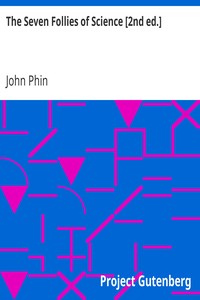The Seven Follies of Science [2nd ed.] by John Phin
"The Seven Follies of Science [2nd ed.]" by John Phin is a scientific publication written in the early 20th century. This work explores some of the most infamous scientific impossibilities and the historical attempts made to solve them, detailing concepts such as squaring the circle, perpetual motion, and the philosopher's stone. By presenting these topics in a straightforward manner, the author aims to make complex ideas accessible to the general reader. At
the start of the publication, the author introduces the concept of 'scientific follies'—problems that have captivated the human imagination despite being mathematically impossible. Phin emphasizes the allure these challenges hold, noting that many seek to solve them out of sheer curiosity and sometimes misguided confidence. In addition to shedding light on various famous problems, he touches upon the historical context and cultural fascination surrounding them, setting the stage for a deeper exploration of each folly in the chapters to follow. Overall, the opening portion lays a foundation for examining the intersection of human curiosity, error, and the relentless pursuit of knowledge in science. (This is an automatically generated summary.)
Read now or download (free!)
| Choose how to read this book | Url | Size | ||||
|---|---|---|---|---|---|---|
| Read online (web) | https://sendtokindle.compellingsciencefiction.com/ebooks/36547.html.images | 344 kB | ||||
| EPUB3 (E-readers incl. Send-to-Kindle) | https://sendtokindle.compellingsciencefiction.com/ebooks/36547.epub3.images | 540 kB |
Send
to kindle email: |
|||
| EPUB (older E-readers) | https://sendtokindle.compellingsciencefiction.com/ebooks/36547.epub.images | 542 kB | ||||
| EPUB (no images, older E-readers) | https://sendtokindle.compellingsciencefiction.com/ebooks/36547.epub.noimages | 196 kB | ||||
| Kindle | https://sendtokindle.compellingsciencefiction.com/ebooks/36547.kf8.images | 1.1 MB | ||||
| older Kindles | https://sendtokindle.compellingsciencefiction.com/ebooks/36547.kindle.images | 1.0 MB | ||||
| Plain Text UTF-8 | https://sendtokindle.compellingsciencefiction.com/ebooks/36547.txt.utf-8 | 294 kB | ||||
| Download HTML (zip) | https://www.gutenberg.org/cache/epub/36547/pg36547-h.zip | 536 kB | ||||
| There may be more files related to this item. | ||||||
About this eBook
| Author | Phin, John, 1830-1913 |
|---|---|
| LoC No. | 06002330 |
| Title |
The Seven Follies of Science [2nd ed.]
A popular account of the most famous scientific impossibilities and the attempts which have been made to solve them. To which is added a small budget of interesting paradoxes, illusions, and marvels |
| Note | Reading ease score: 57.1 (10th to 12th grade). Somewhat difficult to read. |
| Contents | Preface -- The seven follies of science: Introductory note. Squaring the circle. The duplication of the cube. The trisection of an angle. Perpetual motion. The transmutation of metals, alchemy. The fixation of mercury. The universal medicine and the elixir of life -- Additional follies: Perpetual or ever-burning lamps. The alkahest or universal solvent. Palingenesy. The powder of sympathy -- A small budget of paradoxes, illusions, and marvels (with apologies to Professor De Morgan): The fourth dimension. How a space may be apparently enlarged by merely changing its shape. Can a man lift himself by the straps of his boots? How a spider lifted a snake. How the shadow may be made to move backward on the sun-dial. How a watch may be used as a compass. Micrography or minute writing; writing so fine that the whole Bible, if written in characters of the same size, might be inscribed twenty-two times on a square inch. Illusions of the senses (taste and smell; sense of heat; sense of hearing; sense of touch, one thing appearing as two). How objects may be apparently seen through a hole in the hand. How to see (apparently) through a solid brick -- Curious arithmetical problems: The chess-board problem. The nail problem. A question of population. How to become a millionaire. The actual cost and present value of the First Folio Shakespeare. Arithmetical puzzles. Archimedes and his fulcrum. |
| Credits |
Produced by Jonathan Ingram, Stephen Blundell and the
Online Distributed Proofreading Team at http: //www.pgdp.net (This file was produced from images generously made available by The Internet Archive/American Libraries.) |
| Language | English |
| LoC Class | Q: Science |
| Subject | Geometry -- Famous problems |
| Subject | Scientific recreations |
| Category | Text |
| EBook-No. | 36547 |
| Release Date | Jun 28, 2011 |
| Copyright Status | Public domain in the USA. |
| Downloads | 187 downloads in the last 30 days. |
| Project Gutenberg eBooks are always free! | |

